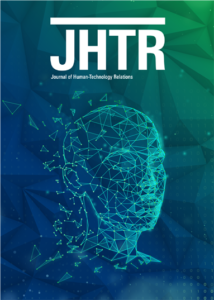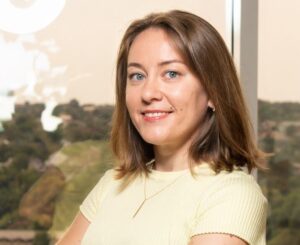In a world where people and technology are increasingly intertwined, the field of postphenomenology offers a framework for understanding the complex and nuanced ways in which technology shapes the human experience. Working in this area, Dr. Olya Kudina, Assistant Professor of Ethics and Philosophy of Technology at TU Delft’s Faculty of Technology, Policy, and Management (TPM), explores how technology influences our moral values and views and how they change in interaction with technology.
Through TU Delft OPEN Publishing, Kudina helped launch the Journal of Human-Technology Relations, creating an inclusive platform for research integrating the growing postphenomenology community with any disciplines relevant to the study of human-technology relations.
Philosophical questions
Technologies not only serve as tools that we use but also actively contribute to shaping our identities, practices, and ways of being in the world. The Ethics & Philosophy of Technology section of TPM, where Kudina works, aims to contribute philosophical insights to achieve responsible innovation of technology. By empirically researching philosophical questions, she tries to understand how to build technologies with human values in mind. At the same time, Kudina said it’s about making technologies adaptable, maintaining functionality in society while being relatable to the changing values that people have.
The impact of AI
Philosophical questions are particularly relevant when it comes to technologies like artificial intelligence (AI). Kudina’s interest in AI started during her PhD with a curiosity about voice assistants like Google Home, Alexa, or Siri. “I became fascinated with the spread of these technologies in people’s homes because I noticed how it started influencing the way people communicate with each other,” she said. “You see how voice assistants construct conversations, the manner in which they expect to be spoken to, and how they change the dynamics in families.” She noticed the influences on the way children start speaking, especially small children, as well as norms around parenting. “It’s interesting philosophically because it’s this type of background constant presence that is not neutral,” she said.
Much of Kudina’s work now relates to AI, including a project with Dutch police and one on mental health care applications with Erasmus MC. And as co-director of TU Delft’s AI DeMoS Lab (Deliberative Multimodal Systems), she leads efforts around AI’s role to facilitate democratic practices in society.
Building a community
Doing her PhD under Professor Peter-Paul Verbeek at the University of Twente was a unique opportunity, said Kudina, noting he’s one of the key figures in the world in postphenomenology. Verbeek, now Rector Magnificus at the University of Amsterdam, led an effort with Kudina’s help to establish a conference called Philosophy of Human Technology Relations. The bi-annual event aims to explore the relations between humans and technologies at the intersection of philosophy, design, ethics, art, and engineering.
The first edition in 2020 welcomed several hundred participants, and despite COVID, hundreds also attended the second virtual conference. Realising that the community was growing, Kudina said they wanted to build on that momentum. “We don’t really have any formal organisation around this theme and we wanted to give people an outlet that was sort of a continuation of the conference,” she said. With that in mind, they started discussing the idea of launching a new journal.
Interdisciplinary journal
 The interesting thing about postphenomenology, said Kudina, is that it’s based in philosophy of technology, but it’s a field that constantly interacts and collaborates on academic work between, for instance, designers, architects, and computer scientists. It is by default interdisciplinary, which can make it difficult to find an outlet to publish. She experienced that herself during her PhD, being told that her work wasn’t suited for philosophy or social science journals. “That’s hard because you wonder if what you’re doing is good enough if it’s not being accepted by academic community, but on the other hand you have the endorsement of peers when you present the work and they see something valuable in it,” she said. The Journal of Human-Technology Relations evolved as an outlet for a broad and inclusive spectrum of research that might not fit into traditional philosophy journals.
The interesting thing about postphenomenology, said Kudina, is that it’s based in philosophy of technology, but it’s a field that constantly interacts and collaborates on academic work between, for instance, designers, architects, and computer scientists. It is by default interdisciplinary, which can make it difficult to find an outlet to publish. She experienced that herself during her PhD, being told that her work wasn’t suited for philosophy or social science journals. “That’s hard because you wonder if what you’re doing is good enough if it’s not being accepted by academic community, but on the other hand you have the endorsement of peers when you present the work and they see something valuable in it,” she said. The Journal of Human-Technology Relations evolved as an outlet for a broad and inclusive spectrum of research that might not fit into traditional philosophy journals.
Open from the start
In addition to maintaining a rigorous review process, another motivation for Verbeek and Kudina was creating an open access journal. “It can be challenging to publish in international journals if your university is not part of a Springer or Elsevier network because not all universities can afford to pay the licensing fees for these journals,” she said. Originally supported by the starting grant from the University of Twente, the journal eventually found its home at TU Delft OPEN Publishing, which has both the technical infrastructure and professional support to publish this journal.
Working with TU Delft OPEN Publishing felt like coming into an ecosystem that has a well-oiled machine, explained Kudina. Unlike other places that she has experienced, Kudina said at TU Delft open science is the general operating principle. “We’re very privileged having a lot of support, not just ideological, but also financial and expertise-based support for people,” she said. “TU Delft has cutting edge expertise on how to do open science and we just wouldn’t be here if it weren’t for their help.”
Doing things differently
The journal, according to Kudina, rests on the shoulders of dedicated managing editors and associate editors who represent 11 disciplinary fields. “To me, that is a vote of confidence in the viability of this journal and why it is there, and that’s very inspiring,” she said. The team strives to ensure that the journal is a high-quality outlet for traditional research papers, but also for something different. They welcome pictorials, which are more design-oriented research articles. Kudina describes this as research through other means, like visualisations, drawings, or exhibitions, that is narrated through text. “We also want to be a venue that inspires early career researchers to participate, which most academic journals do not,” she said. That includes welcoming student essays that might be for some a first exposure to the world of academic publishing. “From the journal perspective, I’m very proud that we’re doing something different.”

